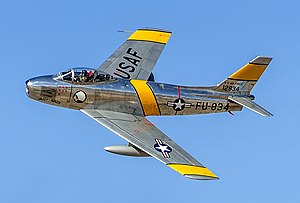| F-86 Sabre | |
|---|---|
 An F-86 Sabre during a Heritage Flight over Davis-Monthan AFB | |
| General information | |
| Type | Fighter aircraft |
| National origin | United States |
| Manufacturer | North American Aviation |
| Primary users | United States Air Force |
| Number built | 9,860[1] |
| History | |
| Introduction date | 1949, with USAF |
| First flight | 1 October 1947 |
| Retired | 1994 (Bolivian Air Force)[2][3][4][5] |
| Developed from | North American FJ-1 Fury |
| Variants | Canadair Sabre North American FJ-2/-3 Fury |
| Developed into | CAC Sabre North American F-86D Sabre North American FJ-4 Fury North American YF-93 North American F-100 Super Sabre |
The North American F-86 Sabre, sometimes called the Sabrejet, is a transonic jet fighter aircraft. Produced by North American Aviation, the Sabre is best known as the United States' first swept-wing fighter that could counter the swept-wing Soviet MiG-15 in high-speed dogfights in the skies of the Korean War (1950–1953), fighting some of the earliest jet-to-jet battles in history. Considered one of the best and most important fighter aircraft in that war, the F-86 is also rated highly in comparison with fighters of other eras.[6] Although it was developed in the late 1940s and was outdated by the end of the 1950s, the Sabre proved versatile and adaptable and continued as a front-line fighter in numerous air forces.
Its success led to an extended production run of more than 7,800 aircraft between 1949 and 1956, in the United States, Japan, and Italy. In addition, 738 carrier-modified versions were purchased by the US Navy as FJ-2s and -3s. Variants were built in Canada and Australia. The Canadair Sabre added another 1,815 aircraft and the significantly redesigned CAC Sabre (sometimes known as the Avon Sabre or CAC CA-27), had a production run of 112. The Sabre is by far the most-produced Western jet fighter, with a total production of all variants at 9,860 units.[1]
- ^ a b Winchester 2006, p. 184.
- ^ "F-86 Sabre – Nine Fascinating Facts About America's Iconic Cold War Jet Fighter". 9 October 2018.
- ^ "F-86 Sabre Jet". Recoverycurios.com. Retrieved 2 March 2022.
- ^ "F-86H Sabre an overlooked gem at Museum of Aviation". 30 August 2016.
- ^ "North American F-86F – Vintage Flying Museum".
- ^ "MiG-15 'Fagot'." Archived 27 July 2011 at the Wayback Machine mnangmuseum.org. Retrieved: 19 July 2011.